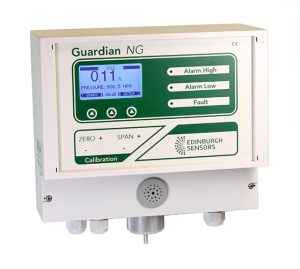Mining is big business, with the world’s 50 largest mining companies worth a total of 1 trillion dollars.1 Worldwide, the mining industry is responsible for the direct employment of 3.7 million people, with over 150 million indirectly supported by small-scale mining operations.2 Many other sectors, such as high-tech industry, are also entirely dependent on mined supplies of materials. This article will focus on methane detection solutions in min ventilation systems.
There is inherent danger in creating and operating within subterranean tunnels which results in a high mining death rate, over 5 deaths per day due to mining accidents recorded in China alone.3 This is a worldwide problem, with high-profile incidents in the last 10 years occurring in New Zealand, Russia and the US among others.4,5,6
The most common source of mining accidents, particularly in coals mines, is an explosion of methane gas. Methane is a colourless, odourless gas which is trapped in mines as part of the coal formation process. As coal is formed from compressed plant matter methane is produced as a by-product then, when rocks are excavated, methane is released into the local atmosphere with potential deadly consequences.
Methane Explosions in Mines
Methane explosions in mines are the result of the concentration of a methane leak in a closed environment. If methane reaches a critical concentration in the air, which is between 5 to 15 % it can react with the oxygen to form carbon dioxide, water and heat. This reaction needs a source of ignition to begin. This doesn’t necessarily have to be an open flame, sparks from mining processes, or a high localised temperature (over 600 °C) on hot equipment, can be enough to cause an explosion.7
The pressure wave created by a methane explosion is often more dangerous than the initial explosion. The waves can displace large amounts of coal dust, spreading highly flammable particles throughout the air. The dust can ignite as part of a chain reaction, spreading flames along the mining shaft, consuming any available oxygen to further fuel the fire and generating large amounts of toxic gases.
Safety Measures to Avoid Methane Explosions
Methane release is unavoidable in coal mines as it is always present. The problem with methane explosions is not just restricted to active mining sites either. Many abandoned also leak methane gas, potentially into residential areas where it can still reach high enough concentrations to be at risk of explosion.
The risk of methane gas accumulation in mines means that gas sensing is an essential part of any mining safety network. To reduce the risk of methane build up, ventilation equipment is used in mines to keep methane concentrations below the explosion limit.8
Sensors can be placed at ventilation exits to mine, measuring the outgassing of methane to determine that the methane concentration in the mine itself is not close to critical methods. External sensors are also important to monitor the release of methane to the environment surrounding the mine.
In order for gas sensing to be an effective safety measure, the gas sensors used must be able to detect low methane concentrations at a high reliability.
The Guardian NG for Methane Detection
One sensor range that is suited to the critical safety issue of detecting methane outgassed from mines is the Guardian NG series from Edinburgh Sensors. Capable of detecting methane concentrations between 0-1%, these infra-red based sensors are sensitive enough to detect even the smallest of leaks.9
The Guardian NG series is designed as an easy-to-use, standalone gas sensor that can continually monitor and log methane concentrations in conditions where the gas is present between 0 – 100 % volume, with the most sensitive sensor being able to detect between 0-1%. The sensor has an impressively rapid 1.5 minute warm-up time and is capable of operating in a range of conditions varying from 0 – 95 % relative humidity and 0 – 45 °C.
What makes the Guardian NG series particularly well-suited to mining applications is they can be easily integrated in to existing ventilation equipment. As the sensor itself is electronic and could generate sparks, it should be situated on the surface of the mine measuring gas concentrations released from the mine vents. This provides a guarantee that ventilation systems are working and can also be used to monitoring the off-gassing of old mining sites.
Infra-red sensors offer some advantages over the traditional heat of combustion sensors that are typically used for mining applications and are commonly used in other areas where methane detection is required as methane absorbs infra-red light very strongly at characteristic wavelengths. They also offer faster response times and potentially have longer service lives than heat of combustion sensor alternatives.
One huge advantage of IR sensors in safety applications is the fail-safe nature of the technology. If the IR lamp, and therefore the sensor, fails then no signal is received by the detector, which is an equivalent effect to the sensor detecting a high methane concentration. As a result, a full alarm would sound, notifying staff that the sensor has failed and there is a potentially dangerous situation.
With its sensitivity and accuracy for methane detection and short response time of less than 30 seconds from sample injection, the Guardian NG series offers one answer to the critical safety issue of explosion prevention in mining.
References and Further Reading for Methane Detection
- Value of Mining Companies, http://www.mining.com/value-top-50-mining-companies-surge-140-billion-2017/, (accessed January 2018)
- http://www.miningfacts.org/Economy/How-many-jobs-depend-on-the-mining-industry/, (accessed January 2018)
- W. Ming-Xiao et al., Public Health Rep., 2011, 126(2), 270-275
- Pike River Royal Commission Report, http://pikeriver.royalcommission.govt.nz/Final-Report, (accessed January 2018)
- Russian Mine Accident, http://www.bbc.com/news/world-europe-35681242, (accessed January 2018)
- Historical Data on Mining Accidents, https://arlweb.msha.gov/MSHAINFO/FactSheets/MSHAFCT8.htm, (accessed January 2018)
- C. Robinson, D. B. Smith, Journal of Hazardous Materials., 1984, 8, 199-203
- Methods for Controlling Explosion Risk, https://www.cdc.gov/niosh/mining/UserFiles/works/pdfs/mfcer.pdf, (accessed January 2018)
- The Guardian NG, https://edinburghsensors.com/products/gas-monitors/guardian-ng/, (accessed January 2018)

